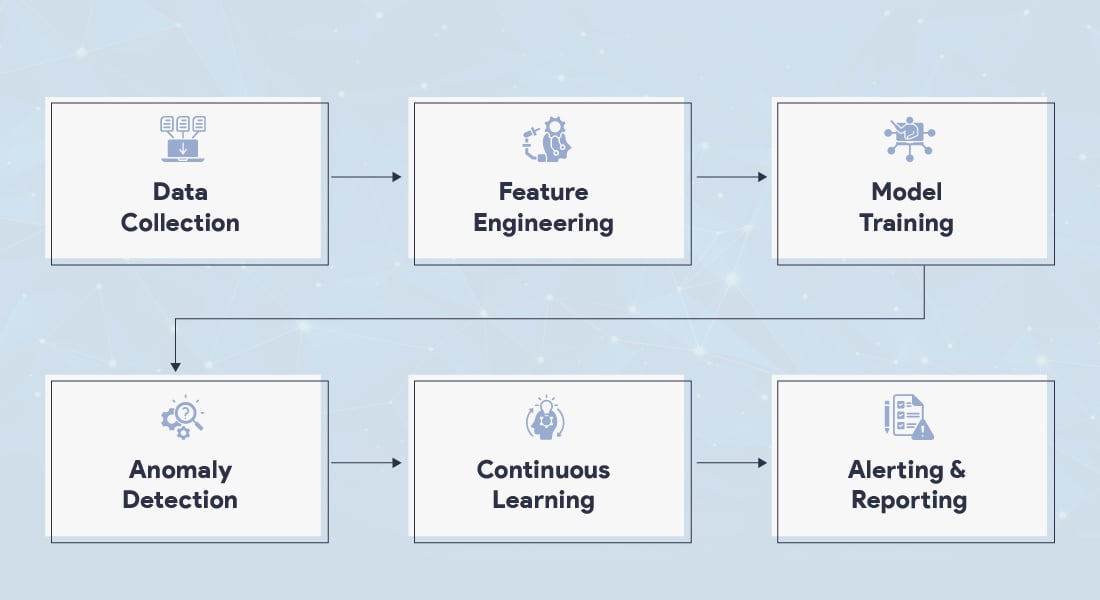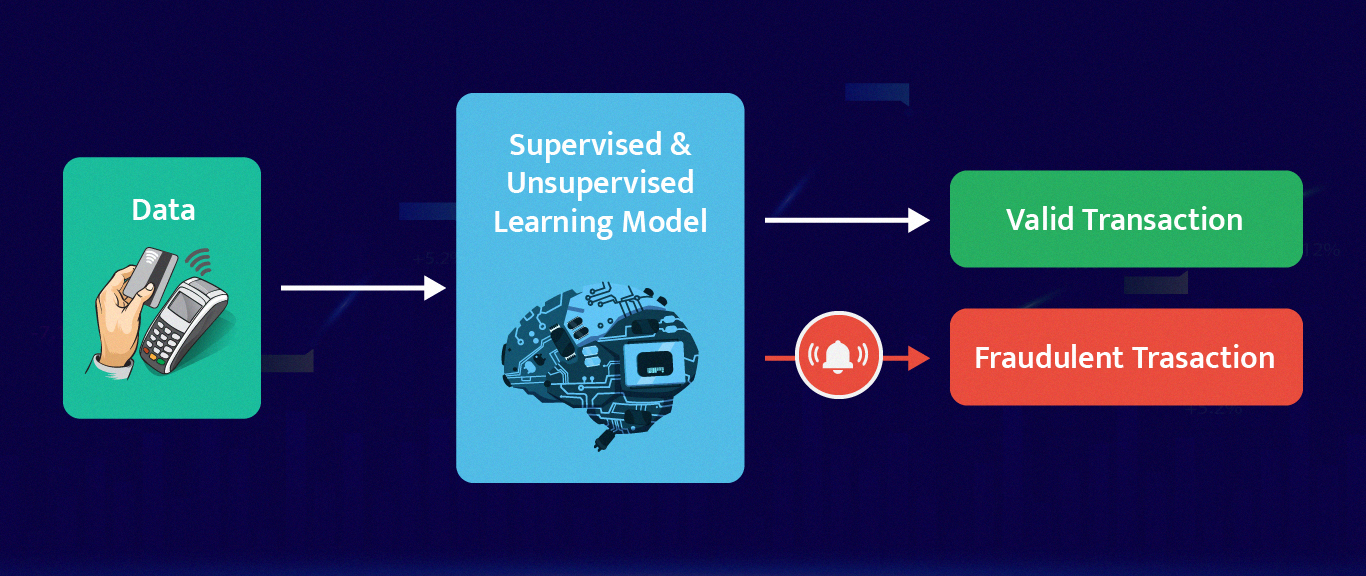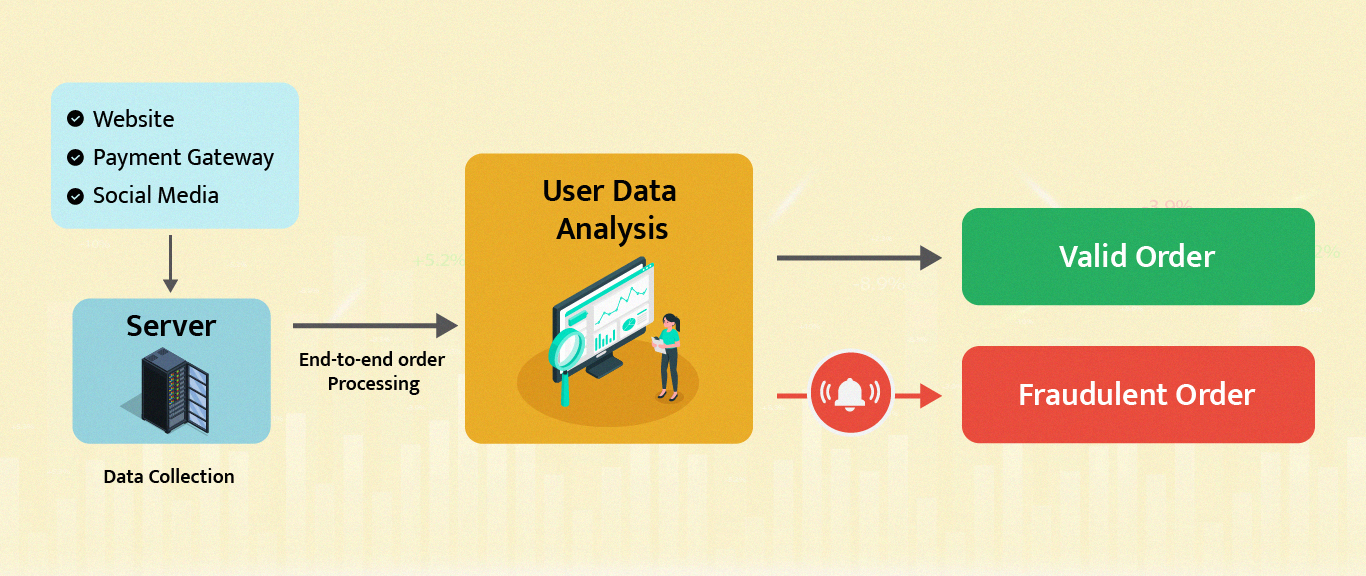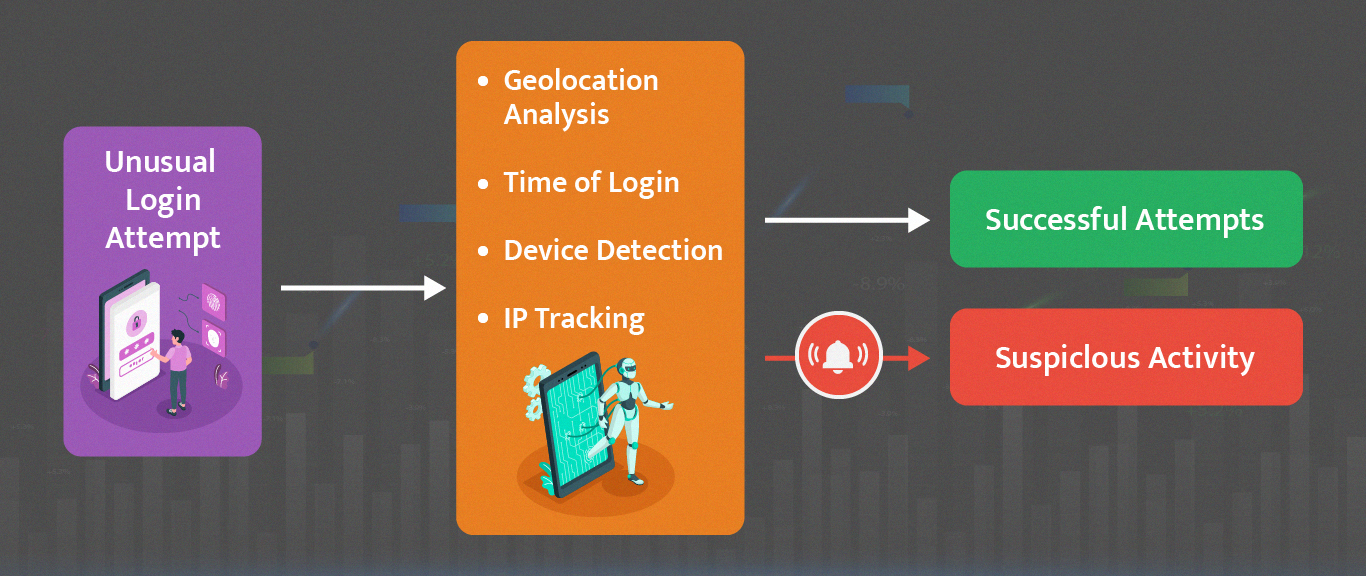AI Fraud Detection: How to Fight Against Digital Fraud
Last Updated on February 18, 2025
Summary
Fraud is a constant threat, but AI is emerging as a powerful weapon in the fight to protect consumers and businesses. This blog dives into AI fraud detection, exploring how it works, the different types of fraud it can combat, and the key benefits it offers.
When it comes to fraud, the finance sector and financial fraud top the chart. The measures to curb it were limited, but with the introduction of artificial intelligence (AI), significant disruption occurred across industries, especially in finance.
According to GBG, the ML model and rule-based fraud systems deployment helped identify new complex security vulnerabilities (leading to financial fraud), improving accuracy by up to 30%. Several frauds occur daily, such as card-not-present theft, identity fraud, phishing attacks, and much more than you can imagine. The attacks are pretty sophisticated, and the victims range from individuals to organizations. Every time a fraud happens, it leaves behind a scarred financial toll and a maligned reputation.
But all the mental agony and financial strain ends if the approach changes. That means one becomes wiser and focuses on a proactive rather than a reactive approach. That starts with adopting an AI fraud detection strategy.
This blog discusses detecting and preventing financial and data fraud using Artificial Intelligence. We promise you that by the end of this blog, you will fully understand what to do—you might have to work on how to do it. Don’t worry; we’ll even help you with that.
The increase in big data and artificial intelligence has provided new possibilities in utilizing sophisticated machine learning algorithms to identify fraud. So, let’s understand the technicalities of AI in fraud prevention and detection.

Due to its superior ability to spot patterns and abnormalities in large datasets, this branch of artificial intelligence has the potential to be used as a fraud detection tool. Here’s what to anticipate:
ML models analyze past data to distinguish between authentic transactions and user activity. Any divergence from the ML models’ classification of valid transactions would label them fraudulent until and unless a legitimate user reverses them.
Real-time transaction processing by machine learning models allows for the early detection of fraudulent transactions, potentially reducing losses.
Complex and suspicious transactions require human expertise, but they cannot concentrate on overloaded mundane tasks. You can hire AI engineers if you face such issues or want to build a product that overcomes such challenges.
Machine learning algorithms enhance fraud detection strategies and accuracy through constant learning from raw data. As fraudsters adapt their techniques, machine learning models likewise change and absorb patterns to keep one step ahead of them.
Deep learning has several benefits for curbing fraud and building user trust. The following are some of the deep learning tactics for curbing fraud detection.
You must consider deep learning to process unstructured data (images, videos, audio, and text) and extract valuable insights. What might have been overlooked using conventional methods is ensured by deep learning, which leaves no loopholes and delivers accurate fraud detection.
Deep learning models excel at identifying unusual transaction patterns that deviate from normal behavior, enabling real-time detection of suspicious activities and swift intervention.
To identify fraud, deep learning examines moving and motionless imagery, including movies and papers. It can detect suspicious activity and falsified documents instantly.
Deep learning analyzes text in emails, chats, and social media to detect fraudulent language and sentiment, uncovering phishing attempts and scams.
Deep learning models adapt to evolving fraud tactics, improving accuracy by continuously learning from new data.
The foundation of efficient fraud detection and prevention is data processing. It entails turning unprocessed data into valuable insights. Large volumes of data can be cleaned, structured, and arranged by organizations to:
Effective fraud detection is based on feature engineering. It entails turning unstructured data into valuable features that draw attention to trends and abnormalities that point to possible fraud. Artificial intelligence (AI) models may effectively detect suspicious transactions by constructing pertinent features, such as transaction velocity, location, time, and consumer behavior. This improves fraud prevention and detection.
Model training is the base for AI fraud detection. The process includes feeding vast amounts of legitimate and fraudulent transaction information to AI algorithms so that they distinguish and identify the ones to flag when repeated. It includes pattern recognition, correlations, and anomalies that highlight fraudulent transactions.
Evaluation follows post-model training, which is critical and attention-demanding, especially when it comes to fraud detection using AI. The process includes testing the trained model’s accuracy by providing a separate database. The purpose of the the entire evaluation is to prepare the AI model so that, irrespective of fraud patterns, the system triggers alerts to users about suspicious activities. With continuous assessment and necessary model improvements, businesses can be worry-free about security threats.
Experience matters; expertise protects. Partner with an AI development company to build a robust defense against fraud. Get a two-hour free consultation now!
As an individual or organization, you must know the different types of digital fraud to protect your customer base. We have categorized them by industry for your convenience, allowing you to quickly find the relevant information and learn how we can partner with you to safeguard your assets. With advanced AI for fraud detection, we can proactively safeguard data and finance from emerging threats.
Financial services and banking systems are highly vulnerable to digital fraud and are on the priority list of cyber attackers. We’ve listed how fraudsters work and the AI fraud prevention and detection process.
Credit card fraud is estimated to reach $43 billion by 2026. To combat this, organizations are turning to AI-based fraud detection in banking.
The problem: Fraudsters steal credit card information and use it for unauthorized online purchases, over the phone, and even by cloning or skimming cards.
The solution: Credit card fraud detection using AI analyzes spending patterns and detects anomalies, like unusual transactions or purchases outside the cardholder’s typical behavior. It helps prevent fraud before it happens, protecting both individuals and organizations.
Payment fraud is a significant concern for businesses of all sizes, causing billions of dollars in losses globally each year. However, proactive steps can be taken to prevent such fraud.
The problem: Fraudsters can obtain credit card details, bank account numbers, or login credentials through various means, like phishing scams, data breaches, or malware attacks. They can even create fake identities and accounts for fraudulent transactions. This fraud occurs online or over the phone, where the cardholder cannot verify the transaction physically. AI combats payment fraud with continuous learning from the historical data of the transactions.
The solution:Businesses can utilize multi-factor authentication (MFA) to add an extra layer of security. They can also implement AI fraud detection software to analyze data in real time, identifying suspicious patterns and anomalies indicative of potential fraud attempts. This helps catch fraud attempts before they drain valuable resources.
Your online accounts hold valuable information, making them targets for unauthorized access. Fortunately, proactive measures can bolster your defenses.
The problem: Hackers use various tactics, like phishing scams, keyloggers, and malware, to steal login credentials and gain access to accounts. Once they have access to critical account information, they can wreak havoc, steal personal data, make fraudulent transactions, or damage your reputation.
The solution: It includes using strong, unique passwords for each account, enabling two-factor authentication, and being cautious about clicking suspicious links or downloading attachments from unknown senders. It’s also beneficial to consider using a top password manager, recommended by Cybernews, to securely store and generate complex passwords for all your accounts. Additionally, consider using AI-powered security solutions to detect suspicious login attempts and alert you of potential threats, helping you keep your online accounts safe and secure.

E-commerce businesses face a significant challenge in the form of online fraud, costing them billions of dollars annually. AI in fraud detection emerges as a game-changer in the fight against e-commerce fraud. AI analyzes transaction size, frequency, and purchase history to identify potential risks. It mitigates card-not-present fraud by comparing shipping and billing information for discrepancies, potentially indicating identity theft. AI combats eCommerce fraud like return and refund abuse by detecting suspicious patterns, saving retailers from costly losses. These systems ensure a secure shopping experience, fostering customer retention and protecting your business.

Insurance fraud is a significant concern for the insurance industry, costing billions of dollars annually. However, artificial intelligence fraud detection has overtaken the insurance sector. Cutting-edge technology touches three significant areas of the insurance sector.
Fabricating or exaggerating the billing amounts to receive higher payouts is an alarming matter, and it has been a significant practice by fraudsters.
The Problem: Fraudsters somehow present inconsistent bills with duped photos.
The Solution: AI can significantly reduce insurance fraud through real-time analysis and image recognition. By analyzing traffic data, weather reports, and police records alongside accident claims, AI can detect patterns indicative of fraudulent claims. Advanced image recognition can enhance insurance fraud detection by scrutinizing photos submitted with claims for inconsistencies like damage that does not match the reported accident or timestamps and locations.

Malicious actors present fictitious claims to the insurance company and get actual money from them. Submitting false or inflated medical bills for reimbursement is a severe threat and must be handled cautiously.
The Problem: Fraudsters can provide fake ownership titles of any asset and state that it was stolen or damaged by accident.
The Solution: Fabricating entire claims becomes much more complicated with AI’s ability to cross-reference vast amounts of data. AI can analyze policyholder information, historical claims data, and external databases to identify inconsistencies. For example, a claim for a stolen boat might be flagged if the policyholder has no history of owning a boat or if the reported location of the theft coincides with suspicious activity patterns.
These general frauds happen daily but are preventable using AI fraud detection practices. Let’s deep dive into each one of them so that you can make an informed decision for your business.
Identity protection is quite critical in this digital world. Cybercriminals constantly seek to acquire personal information, such as names, addresses, Social Security numbers, and financial data, for various malicious purposes, including financial fraud, medical identity theft, tax fraud, etc. Unlike static security measures, AI is continually learning. It analyzes your typical online behavior, including financial transaction patterns, login patterns, and account activity.
Artificial Intelligence (AI) offers a dynamic and adaptable approach to identity theft prevention. Considering the typical behavioral pattern of the user, AI sets it as a threshold and alarms, like sending suspicious login attempts on the added email ID, unexplained password changes, and notifying high-risk transactions. Besides, AI in fraud detection even blocks fraudulent logins and transactions to defend fraudsters. As a result, you can expect proactive prevention, risk reduction, quick response time, and peace of mind.

Phishing attacks remain a prevalent and sophisticated threat. Phishing emails disguised as legitimate sources, like banks or social media platforms, aim to steal sensitive information like credit card details and passwords. These deceptive attempts can lead to significant financial losses and identity theft.
Artificial Intelligence goes beyond simple text analysis and delves deeper into various aspects of an email, including the Subject line and content, Sender information, metadata, etc. Moreover, cutting-edge technologies like Machine Learning and behavioral analysis models promise to differentiate between legitimate and spam emails. Besides, they can identify and adapt to new phishing tactics and emerging trends, staying ahead of attackers.
Empower your team to easily detect and prevent fraud. Hire AI developers to build robust, secure, powerful threat detection solutions.
Fraudulent activity is a persistent threat across industries, causing financial losses, reputational damage, and operational burdens. At Bacancy, we believe using AI in fraud detection is an innovative and dynamic approach needed to combat this challenge.
We leverage AI algorithms to analyze vast amounts of data in real time, pinpointing subtle patterns and anomalies that might escape human detection. This translates to more accurate AI fraud detection and significantly reduced false positives, saving you valuable time and resources.
We create AI fraud detection software that predicts the likelihood of fraud based on historical data and user behavior. This allows for preventive measures, stopping fraud attempts before they occur and safeguarding your organization from harm.
Our AI fraud detection solutions constantly evolve, learning from new data and adapting to new fraud tactics. This ensures you stay ahead of even the most sophisticated fraudsters, no matter their changing schemes.
Our AI expertise allows us to develop systems that identify connections between seemingly unrelated transactions or accounts, potentially uncovering large-scale fraud rings and coordinated attacks.
By preventing fraud, AI minimizes financial losses and frees up resources that can be channeled into other areas, maximizing your operational efficiency.
We ensure a smoother experience for your legitimate customers through faster transaction processing and fewer false positives, fostering increased customer satisfaction and trust.
Undoubtedly, AI in fraud detection has revolutionized traditional fraudulent activities and responses. With evolving technologies, AI’s role in fraud detection will be more significant, promising even more security and efficiency in the future.
Understanding AI algorithms can sometimes be a complicated and time-consuming process, especially regarding AI fraud detection and prevention. Still, with explainable AI, the hassle is a thing of the past. It will tell why AI landed on the conclusion of fraudulent transactions. XAI even builds trust in the technology and stakeholders.
Artificial Intelligence is far, far better than one can even imagine. With ongoing authentication, AI detects how an original user is behaving. For instance, what’s their typing speed, mouse movement, application usage, location, device type, and IP address? Based on the above information, AI predicts whether someone else has taken over the account.
Traditional methods need more data and static analysis. Graph analytics empowers AI to expose complex fraud networks by examining connections (users, transactions, accounts). AI algorithms act as detectives, uncovering hidden links and connecting disparate data to identify coordinated fraud, even the most meticulous schemes.
Synthetic identity fraud, creating fictitious identities using a blend of natural and fabricated data, poses a growing threat. Fortunately, AI emerges as a powerful weapon in this fight. AI’s analytical prowess lies in its ability to discern patterns and inconsistencies within data.
Beyond fraud detection, AI can be crucial to decision-making, including blocking transactions, freezing bank accounts, and notifying users using alerts.
Artificial Intelligence has been vital in proactively detecting and preventing financial fraud. However, the potential of cutting-edge technology is only leveraged optimally when combined with AI consultants and developers. When both workforce and automation join hands, all the heavy lifting is off the shoulders of humans, enabling them to interpret the ongoing data.
The human-AI partnership could be essential in keeping you ahead of the competition and protecting your customers’ valuable resources. Our AI developers help you build robust and defensive AI systems that flag as and when required and save resources. As AI technology develops, so will our ability to detect and prevent fraud, ultimately fostering a safer and more secure digital environment for everyone.
Yes, this new-age technology is worth an investment. Since it comes with several algorithms that flag unusual activities and block them on behalf of the user. Plus, cutting-edge technology (AI and ML) utilizes historical data to understand user behavior and alarm if anything suspicious is signaled.
You can choose from our engagement models, which allow you to hire AI developers hourly, monthly, or fixed-costly. The average cost to integrate AI systems into your digital software to detect and prevent fraud ranges between $1500 and $3000. You can still connect with our AI developers and learn the cost breakdown of the AI solution for fraud detection and prevention.
Not at all. To understand the cost breakdown, you can connect with our AI developers and subject-matter experts, who will primarily understand your challenges and then let you know the AI possibilities required in your business.
Yes, AI is definitely a reliable, cutting-edge technology that detects and prevents fraud from happening. AI-powered fraud detection processes data at incredible speeds and identifies illegitimate transactions that remain unnoticed through human eyes. AI helps with real-time anomaly detection, pattern recognition, predictive analytics, and image & video analytics to beat fraudsters.
Your Success Is Guaranteed !
We accelerate the release of digital product and guaranteed their success
We Use Slack, Jira & GitHub for Accurate Deployment and Effective Communication.